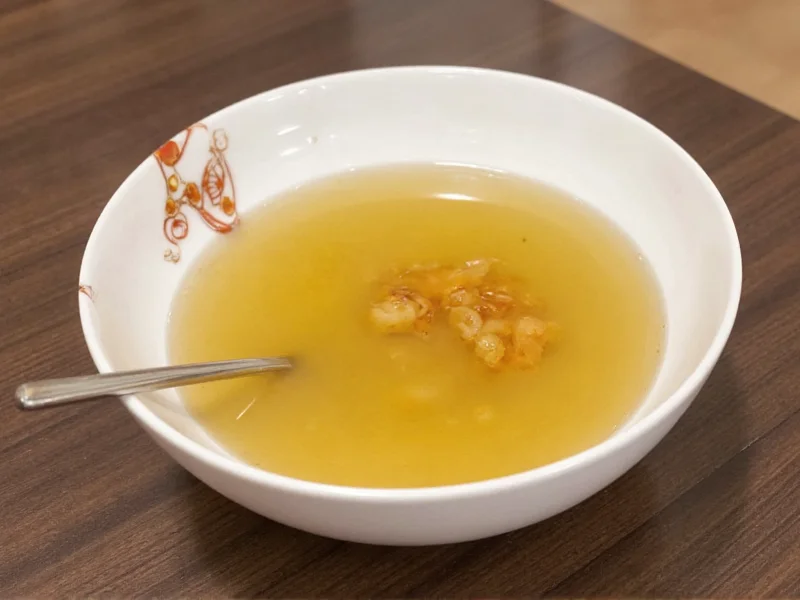The Art and Science of Perfect Clear Soup
Clear soup represents one of culinary arts' most elegant achievements—a seemingly simple preparation that demands precision and understanding of food science. Unlike hearty stews or chowders, clear soups showcase transparency as their defining characteristic, requiring careful technique to achieve that pristine, jewel-like quality that professional kitchens prize.
Why Clarity Matters in Soup Making
The difference between a cloudy broth and crystal-clear soup isn't merely aesthetic—it reflects fundamental food chemistry principles. When proteins and fats emulsify into liquid through vigorous boiling, they create permanent cloudiness. Mastering clear soup means understanding how to extract maximum flavor while keeping these elements separated.
Essential Components for Authentic Clear Soup
Three elements form the foundation of exceptional clear soup:
| Component | Critical Role | Professional Tip |
|---|---|---|
| Bones & Meat | Flavor foundation | Blanch bones first to remove impurities |
| Aromatics | Complexity without clouding | Add delicate herbs late in cooking |
| Clarifying Agents | Removes suspended particles | Egg whites work best for consommé |
Step-by-Step Clear Soup Recipe
Follow this professional method for consistently clear results:
- Prep ingredients: Blanch 2 lbs meaty bones in boiling water for 3 minutes, then rinse
- Cold start: Place bones in 8 cups cold water; bring to near-boiling slowly
- Skim carefully: Remove foam with spoon as it forms during first 20 minutes
- Simmer gently: Maintain temperature at 180-200°F (82-93°C) for 3-4 hours
- Add aromatics: Introduce mirepoix after first hour of simmering
- Strain properly: Use fine mesh strainer lined with cheesecloth
- Final clarification (optional): For consommé, use egg white raft technique
Avoiding Common Clear Soup Mistakes
Even experienced cooks make these critical errors when attempting clear soup recipes:
- Boiling instead of simmering - Rapid bubbles break apart proteins causing permanent cloudiness
- Skipping the blanching step - Raw bones release more impurities during cooking
- Adding cold ingredients to hot broth - Temperature shock creates cloudiness
- Overcrowding the pot - Too many ingredients prevent proper clarification
- Using high-starch vegetables - Potatoes and corn naturally cloud broth
Advanced Consommé Technique
For ultimate clarity, professional kitchens use the consommé method:
- Create a "raft" by mixing 4 egg whites with 1 cup minced lean meat and aromatic vegetables
- Add raft mixture to warm (not hot) broth
- Slowly bring to simmer while stirring constantly until raft forms
- Cover with parchment paper and simmer 45-60 minutes
- Carefully strain through multiple layers of cheesecloth
This technique traps impurities in the solid raft, leaving behind perfectly transparent broth with intensified flavor. The process requires patience but delivers extraordinary results that showcase your culinary expertise.
Clear Soup Variations Worth Mastering
Once you've mastered the basic technique, explore these classic variations:
- Oriental clear soup - Use ginger and star anise with chicken bones
- Vegetable consommé - Substitute meat with mushrooms and leeks
- Fish consommé - Use white fish bones with fennel and lemon
- Tomato water - Modern interpretation using tomato clarification
Serving Clear Soup with Professional Presentation
Clear soup deserves elegant presentation:
- Use warmed, shallow soup plates rather than deep bowls
- Add minimal garnishes that enhance clarity (thinly sliced scallions, micro herbs)
- Serve at proper temperature (160-170°F/71-77°C) to maintain transparency
- Consider edible flowers for special occasions
Remember that clear soup often serves as the first course in fine dining because its delicate nature prepares the palate for subsequent dishes. This culinary tradition spans Japanese dashi, French consommé, and Chinese superior soup—all sharing the same fundamental principles of clarity and purity.











 浙公网安备
33010002000092号
浙公网安备
33010002000092号 浙B2-20120091-4
浙B2-20120091-4